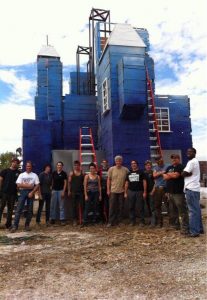May 12, 2009 – On a cold November day in 2007, Georgia Willis sat on her scooter as a CTA bus lift lowered her to the ground. Before she knew it, the scooter had tipped off the lift and she hit her face on the bike rack and was underneath the 40-foot, 27,000-pound bus. The driver of the Addison 152 bus did not budge from his seat, she says, but several passengers got off to help.
The then-69-year-old woman says a passenger suggested she call an ambulance, but she refused because she felt fine and had to get to a job interview. Willis says she regrets not seeking medical treatment immediately because when she got home that day she felt tremendous pain in her head and jaw.
Willis called an ambulance that night and was taken to John H. Stroger Hospital, where medical reports show doctors treated her for back pain, a severely bruised thigh and swollen jaw. After staying overnight at the hospital, Willis says she was bed-ridden for the next three weeks.
Willis filed a claim Nov. 12, 2007, detailing her version of the accident. The Chicago Transit Authority denied Willis’ claim six months later in a letter stating, “We have made a careful investigation and on review of our file have concluded that we are not liable.”
After repeated requests, the CTA declined to comment on Willis’s accident, though Vernon Williams, general manager of the CTA Claims Department, in an e-mail provided a timeline of its correspondence with Willis, citing a lack of proper paperwork as the reason for the denial of her claim.
Willis says she is upset with the way the CTA handled her claim.
“The bus driver never even submitted an incident report because these people don’t even really care. I was left underneath the bus,” says Willis, who’s used the bus only a handful of times since.
“I’m back to my old ways, riding the streets. Since I have taken the CTA, I know what I am in for, and I don’t know if I want to go that route again,” said Willis.
Willis’ accident is one example of the challenges people with disabilities face when using the CTA. Some advocacy groups say the transit system has become more accessible in the wake of a 2000 lawsuit, while others, like Willis, say the CTA does not do nearly enough to accommodate the disabled.
Janice Stachwick, a civil rights and transit advocate for the local disabilities group Access Living, needs the bus ramp lowered to board the bus. Stachwick says there have been several times when CTA bus drivers refused to lower the lift because they claimed it was broken or told her she didn’t need it.
“They don’t get to decide if I have a disability,” says Stachwick, who uses a cane to walk.
A review of the roughly 2,000 complaints filed with the CTA from Jan. 1, 2004, through Feb. 28, 2009, turned up dozens of similar complaints each of those years, including instances of disabled customers waiting for four, five and six buses at a time – sometimes in the bitter cold and blowing snow – before a lift or ramp would be lowered.
In fall 2000, Access Living sued the CTA for violating the federal Americans with Disabilities Act . The lawsuit, filed jointly with Equip for Equality and nine disabled plaintiffs, listed several complaints against the CTA, including failing to inspect and maintain bus lifts, and bus drivers failing or refusing to lower bus lifts for disabled passengers.
In the 2001 settlement, the CTA agreed, among other things, to keep a database of all ADA-related complaints and implement “Corrective Action Guidelines” to discipline employees who refuse to lower bus lifts. The CTA declined to discuss whether any employees have been disciplined as a result of violating these guidelines.
Some disabled riders say they have few problems using the transit system since the lawsuit was settled nearly eight years ago. Tim Sullivan, a disability advocate who also serves on the CTA’s ADA Advisory Committee, says the CTA is doing a decent job of accommodating people with disabilities.
Sullivan, who has muscular dystrophy and has used a wheelchair since his early teens, has worked 25 years for Chicago ADAPT, a disability rights group.
He uses the CTA almost every day, boarding the Brown Line Train at the Armitage station two to three times a week sometimes up to three times a day.
Sullivan says he does not mind when an automatic door is broken – a problem found at 11 stations designated by the CTA as handicapped accessible when a team of Columbia College Chicago students visited all 144 of the CTA’s train stations earlier this year.
“I don’t nitpick at the little stuff …but what pisses me off more is an elevator not working for two weeks. I would rather have a broken door than an elevator. A door I can have someone open for me, but no one can carry me up the stairs in a wheelchair,” said Sullivan.
Sullivan says now there are usually one or two elevators out of service daily when before the lawsuit there would be 10 or more. The ADA does not require a specific timeframe for elevator repairs, but the settlement agreement instructs the CTA to make reasonable efforts to ensure they are working properly. The CTA declined to discuss its record of repairing equipment or whether it’s still following the terms of the agreement.
“I have had my problems with the CTA and I am not their defender, but I can always give the CTA the benefit of the doubt,” he says.
Laura Miller, the managing attorney for the local disabilities group Equip for Equality who worked for Access Living at the time of the lawsuit, says complaints have declined.
During the two years prior to the lawsuit, she says Equip for Equality and Access Living had received over 350 accessibility-related complaints. Despite the lawsuit, the number of CTA complaints is rising. There were 402 ADA-related complaints in 2008, and that number could be even higher by the end of 2009, with 70 complaints already recorded in the first two months of the year.
“People filed a lot of complaints and nothing changed. That’s when we decided to sue,” said Miller.
Miller says there wasn’t an effective place for people with disabilities to complain, but now the lawsuit requires the CTA to have a centralized system to compile and organize complaints. The CTA declined to comment on its procedure for organizing and maintaining such a database.
Both Stachwick and Miller say these days, their advocacy groups rarely receive complaints about the CTA, but that doesn’t mean all is fine.
“I don’t think the fact that we don’t get any complaints is because there are no problems,” Miller said. “People just complain directly to the CTA now. I guess we’d only hear about it if they didn’t get a response.”
Despite improvements made by the CTA, Willis says people like Sullivan “need to check again and this time pay attention. They would see not everyone feels the same way as them.”
Willis says she still feels pain in her back and thigh and hasn’t given up her fight with the CTA.
“I just want someone to acknowledge that the accident happened. You know, I have to live with this,” said Willis. “I now have more compassion for what others go through, and it’s important to me to fight for what I believe in.”
Danielle Desjardins and Kaitlyn McAvoy contributed to this report.
Contact Kirsten Steinbeck at kirstensteinbeck@gmail.com.
Check out the rest of the CTA investigation:
Investigation Finds Handicapped Accessibility Issues Plague CTA by Zach Wilmes
Broken CTA Facilities, Slow Repairs Create Problems for Disabled Customers by Elizabeth Czupta
Complaints Against CTA Keep Climbing by Danielle Desjardins and Kaitlyn McAvoy
Disabled Riders Experience Years of Inconsistency in CTA Service by Danielle Desjardins
Advisory Group Works to Improve Access for Disabled CTA Riders by Kirsten Steinbeck
ChicagoTalks Video: CTA Improves But Some Disabled Still Complain by Elizabeth Czupta
INVESTIGATION: Disabled And Downtown On The CTA by Eli Kaberon
INVESTIGATION: The Inaccessible CTA by Kaitlyn McAvoy











Be First to Comment